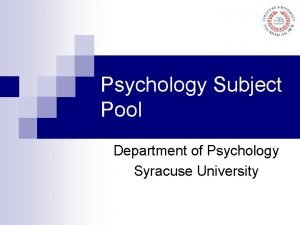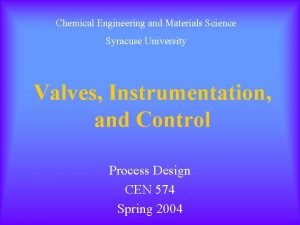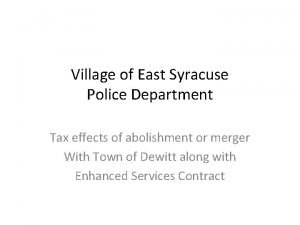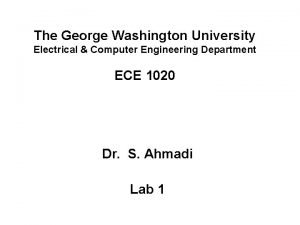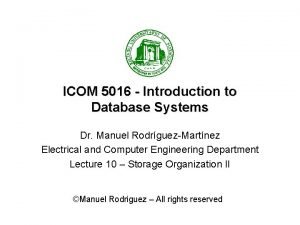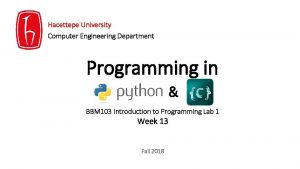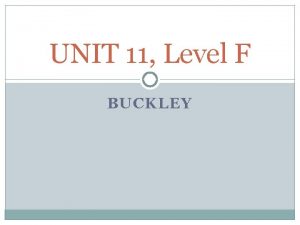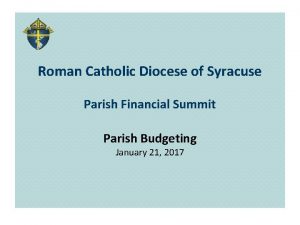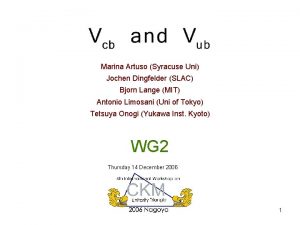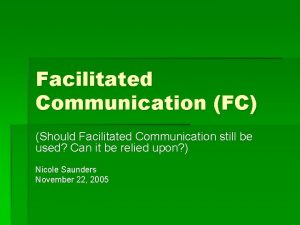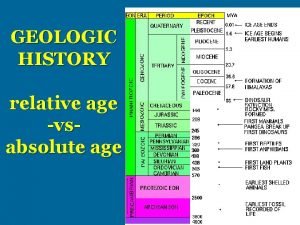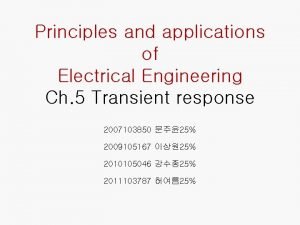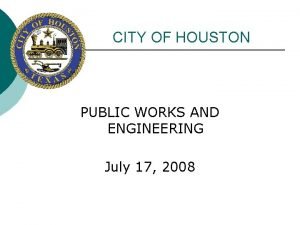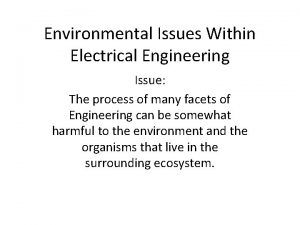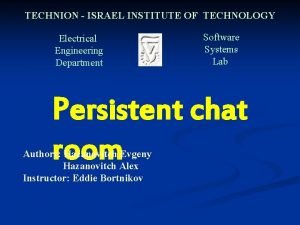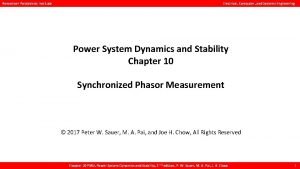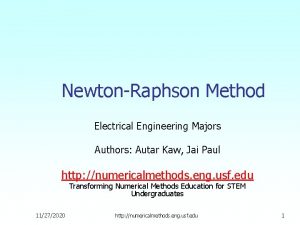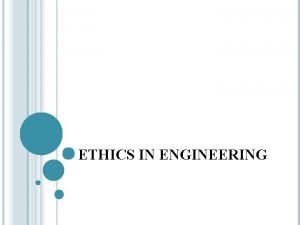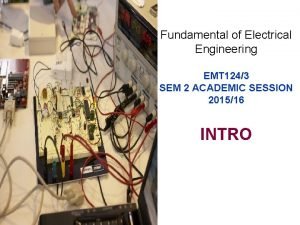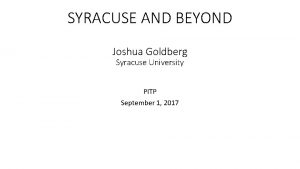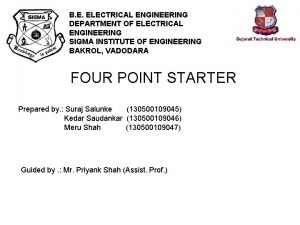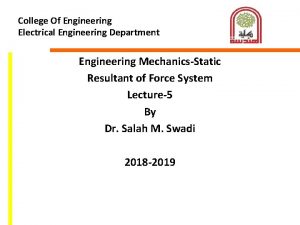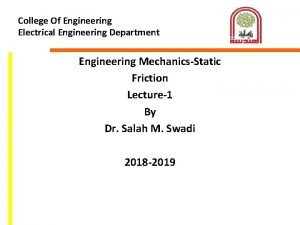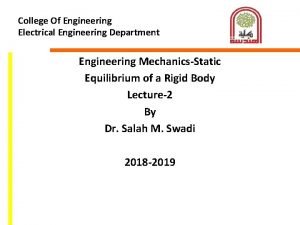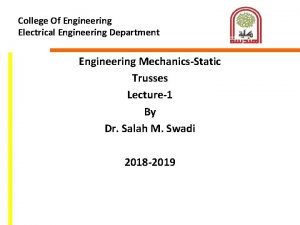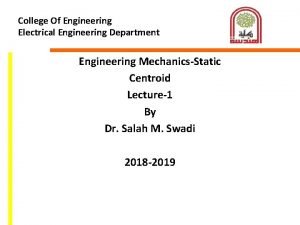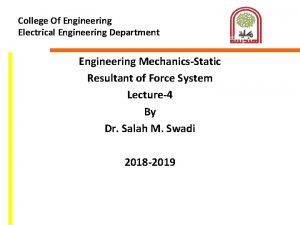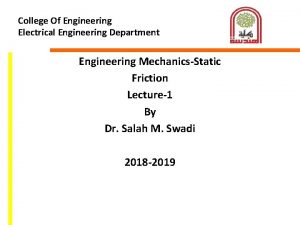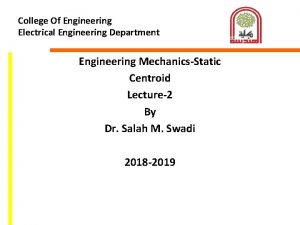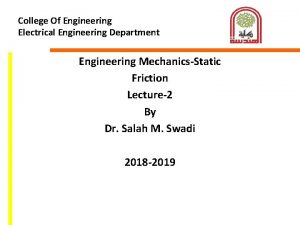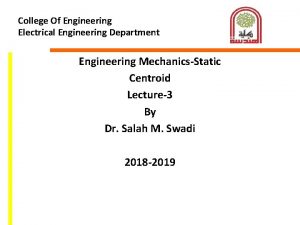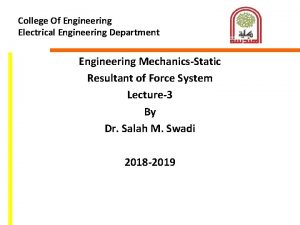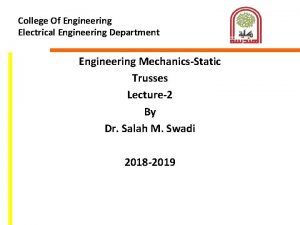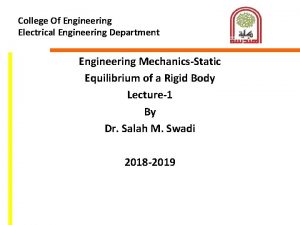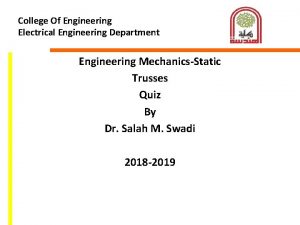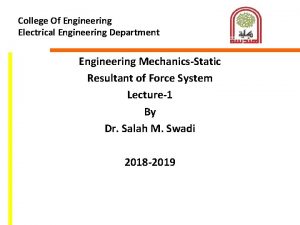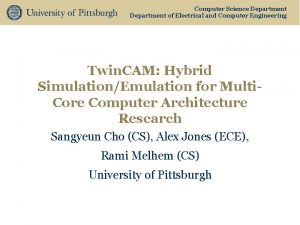Syracuse University Department of Electrical and Computer Engineering






![Steps to Refactoring �Error 1. Selection messages [58] of (Eclipse) Code Fragments �Selected block Steps to Refactoring �Error 1. Selection messages [58] of (Eclipse) Code Fragments �Selected block](https://slidetodoc.com/presentation_image_h/9792199b433e10eb0e703f02a1ff2bd4/image-7.jpg)
![Identifying Refactoring Opportunities �Refactoring is based on human intuition [5] �Although Fowler introduces many Identifying Refactoring Opportunities �Refactoring is based on human intuition [5] �Although Fowler introduces many](https://slidetodoc.com/presentation_image_h/9792199b433e10eb0e703f02a1ff2bd4/image-8.jpg)






















































![Bibliography � � � � [2] Grady, Robert B, "Practical Software Metrics For Project Bibliography � � � � [2] Grady, Robert B, "Practical Software Metrics For Project](https://slidetodoc.com/presentation_image_h/9792199b433e10eb0e703f02a1ff2bd4/image-63.jpg)


- Slides: 65

Syracuse University Department of Electrical and Computer Engineering Identifying Extract Class and Extract Method Refactoring Opportunities Through Analysis of Variable Declarations and Uses Mehmet Kaya Ph. D Dissertation 5/30/2014 1

Outline �Introduction and Problem Presentation �Overview of contributions �Cohesion and Refactoring �Extract Method - Placement Tree �Extract Method - Hammock Graph �Conclusion and Future Work 2

Maintenance Phase • Changes usually degrade quality of software. • Supports the software product from its inception to its retirement and ends with product’s retirement [50] • Lasts for 10 to 20 years [3] • Increases the cost of production dramatically • Maintenance effort = 2|3 x Creating new software [2] • Comprising 60 -75% of the overall cost [3, 72, 51] 3

Software Quality vs. Cost �Developing a large system requires a team. �Each component will be read and used by other developers. �Software may be modified/maintained by developers who are not original authors. �Some quality aspects: �Cohesion �Comprehensibility/ Cyclomatic Complexity �Readability �Reusability 4

Quality vs. Bad Smells in Code �Duplicated Code – identical or very similar code exists in more than one location �Long Method –method that has grown too large �Large Class – class that has grown too large �Long Parameter List – hard to understand/read �Feature Envy – a class that uses methods of another class excessively 5

Software Refactoring • Refactoring is defined by Fowler et al. as "the exact reverse of the normal notion of software decay" [5] • Example: • Renaming an attribute • Extraction of new units • Goal: to make the software easier to understand modify. • Result: better understandable/readable/reusable code or reduced cost of maintenance/production 6
![Steps to Refactoring Error 1 Selection messages 58 of Eclipse Code Fragments Selected block Steps to Refactoring �Error 1. Selection messages [58] of (Eclipse) Code Fragments �Selected block](https://slidetodoc.com/presentation_image_h/9792199b433e10eb0e703f02a1ff2bd4/image-7.jpg)
Steps to Refactoring �Error 1. Selection messages [58] of (Eclipse) Code Fragments �Selected block references local type declared outside the a) Read the software code toaget familiar selection: local declaration is not part of the selection but b) Inspect. Athe codetype to find code regions is 2. referenced the statements selected for extraction. Extractionby of one Codeof. Fragments �A a) local type declared in theofselected block is referenced outside Determine the feasibility refactoring the The selection covers a local typewith declaration but the b) selection: Perform Refactoring / Create method – replace method call type is also referenced outside the selected statements. �Error messages are non-specific and unhelpful in diagnosing problems Manual! [73] �Discouraging programmers refactoring Eclipse, Visual Studio, from Resharper, Refactor at Proall [73] 7
![Identifying Refactoring Opportunities Refactoring is based on human intuition 5 Although Fowler introduces many Identifying Refactoring Opportunities �Refactoring is based on human intuition [5] �Although Fowler introduces many](https://slidetodoc.com/presentation_image_h/9792199b433e10eb0e703f02a1ff2bd4/image-8.jpg)
Identifying Refactoring Opportunities �Refactoring is based on human intuition [5] �Although Fowler introduces many different kinds of refactoring, the identification of location where to apply these re-factorings is ambiguous [5] �Developer is the last authority to decide where to apply the refactoring [46] �Although refactoring is practiced very frequently, 90 percent of refactoring is applied manually and refactoring tools need further improvements [64, 65] 10

Goal of Our Research �Refactoring is acknowledged to be a subjective ambiguous process �Our contribution turns that into an objective quantitative process �Find techniques for suggesting refactoring �Implement the techniques in tools �Produce result that can be represented visually �No need to inspect code to detect refactoring �Developer is still the last authority 11

Overview of Contribution 1 �Large Class Code Defect �Fowler suggests based on number of data member [5] �Simple and cohesive, understandable, and readable �Cohesion is simply the degree to which the elements of a module belong together �Higher quality=better reuse and maintainability �“Should capture one and only one key abstraction” [78] �Remedy: Extract Class Refactoring �Extract each distinct task as a separate unit 12

Some Results of Contribution 1 �Extract Class Refactoring Before and After # of Methods # of Data Members # of Lines Original Class 13 9 150 Class After Refactoring 13 3 72 Extracted Class 1 6 2 49 Extracted Class 2 12 3 105 Extracted Class 3 5 4 35 13

Overview of Contribution 2 �Long Method Code Defect �The source of many other code defects [1] �Smaller methods are easier to read, comprehend, and maintain [1] �Is this a subjective measure? �Should be shorter with one clear intention �Remedy: Extract Method Refactoring �Extract appropriate code fragments as separate methods 14

Some Results of Contribution 2 �Extract Method with Placement Tree Before and After Method: W_Calculate Domain: Medical # of Extraction: 9 LOC Cyclomatic Complexity Before Refactoring 379 Method: do. Action Domain: Analyzer #46 of Extraction: 3 After Refactoring 39 LOC 4 Cyclomatic Complexity Extracted Method 1 13101 Before Refactoring 44 3 Extracted Method 2 1321 3 After Refactoring 3 Extracted Method 3 1 1352 Extracted Method 27 3 Extracted Method 4 2 1320 Extracted Method 11 3 Extracted Method 5 3 1921 5 Extracted Method 6 33 9 Extracted Method 7 16 5 Extracted Method 8 45 9 Extracted Method 9 62 11 15

Overview of Contribution 3 �Long Parameter List Code Defect �Impact the quality of software programs dramatically �“Difficult to understand test ” [5] �Maintenance phase requires more time and effort �Extract Method may result in long parameter lists �We do not identify existing long parameter lists. �Provide an opportunity to observe extract method refactoring opportunities based on the desired length of parameter list 16

�Extract Method with Hammock Before and After Some Results of Contribution 3 Method: run_dlg. Proc Domain: Notepad++ # of Extraction: 25 LOC Cyclomatic Complexity # of Parameters Before Refactoring 560 54 3 After Refactoring 269 35 3 Extracted Method 1 19 1 0 Extracted Method 2 9 2 0 Extracted Method 3 13 3 0 Extracted Method 4 28 5 0 Extracted Method 5 5 1 0 Extracted Method 6 6 1 0 Extracted Method 7 8 1 0 Extracted Method 8 6 1 0 Extracted Method 9 6 1 0 Extracted Method 10 15 2 0 Extracted Method 11 6 1 0 Extracted Method 12 14 2 0 Extracted Method 13 7 1 0 Extracted Method 14 7 1 0 Extracted Method 15 7 1 0 Extracted Method 16 6 1 0 Extracted Method 17 5 1 0 Extracted Method 18 8 2 0 Extracted Method 19 4 1 0 Extracted Method 20 5 1 0 Extracted Method 21 20 3 1 Extracted Method 22 21 4 1 Extracted Method 23 19 3 1 Extracted Method 24 17 2 1 Extracted Method 25 17 3 2 17

Tools and Techniques �Rule Based Parser (Dr Fawcett) �Developed a rule based ad-hoc parser �Analyzes source code to extract information �Results we seek depend on only a small part of the language grammar �Simple design and very flexible to extend � Designed on an Actions and Rules based approach 18

19

Tools and Techniques (cont'd. ) �Program Slicing �“The method of automatically decomposing programs by analyzing their relationships between statements based on data and control flow” [9] �Slicing criterion: C= (9, sum). 1 2 3 4 5 6 7 8 9 10 int i; int sum = 0; int product = 1; for(i = 0; i < N; ++i) { sum = sum + i; product = product *i; } cout<< sum; cout<< product; int i; int sum = 0; for(i = 0; i < N; ++i) { sum = sum + i; } cout<< sum; 20

Tools and Techniques (cont'd. ) �Graph Theory - Hammock Graphs induced sub-graph of G with a distinguished node V in H called the entry node and a distinguished node W not in H called the exit node such that 1. All edges from (G - H) to H go to V. 2. All edges from H to (G - H) go to W. 22

Tools and Techniques (cont'd. ) �Tools we developed - Analysis �Brace Insertion: detects scopes, inserts missing braces, indents statements: enhanced readability and easier analysis �Tree Generator: for each scope detects; source code, line numbers, variable references and produces an XML representation �Hammock Graph Constructor: detects variable spans for each local variable, control blocks and interactions and produces an XML representation 25

Tools and Techniques (cont'd. ) �Tools we developed – Visualization �Each box is a scope – this code is complex 26

Contribution 1: Class Cohesion and Refactoring �Started to explore refactoring through variable declaration and uses �Published in conference proceedings �Goal: to quantitatively measure the cohesiveness of a class �Should be able to help with suggesting refactoring Contribution 2 Contribution 3 Computer Software and Applications Conference Proceedings 37

Page 36 of Dissertation Construction of Slices �Slicing Criteria �Existing approaches require user-selected criteria �Slicing Criteria defined as: �DMC is the union of all private data members defined in class C. �STdx. C is the set of all program statements using data member d in C where d Є DMC. 38

Relationships Between Statements Line# Original Program Slicing Result Our Result 1 2 3 4 5 6 7 8 9 10 int i; int sum = 0; int product = 1; for(i = 0; i < N; ++i) { sum = sum + i; product = product *i; } cout<< sum; cout<< product; Relationships for(i = 0; i < N; ++i) { sum = sum + i; } cout<< sum; 39

Page 41 of Dissertation Determination of Our Slices �SLstx. C is the set of all program statements which are related to the statement st based on the conditions �SLdx. C is the union of all SLstx. C where st Є STdx. C and d Є DMC. �SLdx. C= 44

Data Slice Graph �We generate a Data-Slice-Graph (DSG) to evaluate cohesiveness of the class �It provides information for evaluating cohesion and suggesting refactoring �Each node represents a data member of the class �Edges are due to the relationship between slices 45

Data Slice Graph �DSG= (V, E) is a undirected graph such that V is the finite set of data members representing vertices in the graph and E is the finite set of relationships between data members representing edges in the graph. �|V| is the number of data members of the class �v 1 v 2 Є E iff SLv 1 x. C ∩ SLv 2 x. C ≠Ø 46

Cohesion Metric �Quantitative and Constructive �It is defined as the number of connected components, NC in its DSG �The bigger NC, less cohesive our class is �Each connected component in DSG refers to one abstraction 47

Possible Cohesion Values �NC = 0 means class does not have any data members. �NC = 1 occurs when the class has only one abstraction �NC > 1 occurs when the class has more than one abstraction. 48

Suggesting Extract Class Refactoring �C 1 and C 2 represent two different abstractions �C 1 = v 1 -v 5 with slices �C 2= v 6 -v 8 with their slices �Each consecutive set of statements in the slice of any data member constructs a method v 2 v 1 v 6 v 7 C 2 C 1 v 3 v 4 v 5 v 8 49

Resultant DSG y 1 top rawtime funinvokes stk x 2 x 1 top. Invok y 2 53

Before and After 55

Example 2 �NC=1 56

Summary of Contribution 1 �We have proposed a new cohesion metric and an extract class refactoring �Uses a technique similar to slicing �Slicing Criteria defined based on variable references �It is at the statement level �Unlike Clustering, does not suggest moving attributes between classes �We do not change the interface of the class �Cannot measure for classes with no data members. 57

Contribution 2: Identification of Extract Method Refactoring using Placement Trees �We try to build comprehensible, readable, and simple code �The refactored methods are optimal and extend the lifetime of programs [4, 5] �Extract Method refactoring consists of two major activities: identification and extraction �The goal is to create methods with focus on a single task Contribution 1 Contribution 3 SEKE – Software Engineering and Knowledge Engineering Conf Proceedings 58

Placement Trees �Placement of scopes in a method 59

Placement Tree �Contains variable reference counts for individual scopes: 60

Dominant Variables �Let V(F)={ v 1, v 2, . . , vn } represent the set of all variable names 61

Dominant Variables �Heuristic: Variable with highest reference count is the dominant variable �Let D(B) represent the dominant variables in scope B, 62

Overall Refactoring Process 66

Refactoring Suggestion Large code fragments with a color different from parent's color. 2. Consecutive sibling nodes with the same color. 1. 67

Experiments �Analyzer – Our Tool 72

Experiments �Medical Imaging Research Code -> from 400 to 40 73

Experiments �Medical Imaging Research Code -> 4000 �Notepad++ - > 800 74

Summary of Contribution 2 �Main focus is on identification of code fragments �Introduced techniques and tools based on placement trees and variable reference counts �Works effectively in real software systems �Current heuristic works well, future improvements are planned �Visual representation helps user observe refactoring suggestion easily �Do not consider goto statements! �May result in long parameter lists! 75

Contribution 3 Refactoring using Hammock Graphs �This contribution focuses on managing the number of arguments in an extracted method’s parameter list �In contribution 2, length of parameter lists is omitted �A long parameter list increases the complexity of a method and makes it difficult to maintain and to comprehend Contribution 1 Contribution 2 Under Review: IEEE Transactions on Software Engineering 76

Constructing of Hammocks �Our technique proceeds in following steps: 1. Generate the initial graph of variable declarations and references together with control blocks 2. Convert all variable span into hammocks 3. For each hammock, determine the number of variables referenced in the hammock 4. Visualize the candidates based on a selected number of parameters dynamically 5. Observe refactoring opportunities, re-factor the code and continue if necessary 79

Page 86 of Dissertation Initial Graph �G= (V, E) is a directed graph such that V is the set of program statements and E represents variable relationships �L is the set of all local variables �D(l) = statement where l is declared �LR(l) = statement where last reference of l appears 80

Initial Graph �Therefore: �Furthermore, let the set C, line number S(c), and line number E(c) represent the set of all control statements in the given method, the line number where the �Therefore: 81

Initial Graph Example 82

Problems with the initial graph Extraction of a variable span from the initial graph may split a control block. 2. Extraction of a variable span from the initial graph into a new method may move the declaration of another local variable to a new scope leaving references of that variable in the original method. 1. 83

Generating Hammocks 1. Variable Spans 2. Control Edges and Variable Spans 84

Extended Graph 85

Extended Graph �Each reference edge represents a hammock �Therefore they are extractable �One can observe all possible extract method refactoring opportunities with a selected number of arguments dynamically through a visual representation 86

Observing Refactoring Opportunities 87

Experiments �The size of these boxes shows the length of the method or code fragment �The color is determined based on the number of arguments prospective methods will take 88

89 Experiments

90 Experiments

Summary of Contribution 3 �A new technique and tool are introduced to identify code fragments for method extraction with constraints on number of parameters. �Developers have the opportunity to observe different code fragments suggested as candidates for method extraction based on a desired number of arguments. �Novel visualization and technique to observe based on desired number of parameters �Will not work effectively with methods that do not have any local variables �Extracted methods can be smaller when variables are declared as close to where they are used as possible 91

Conclusion and Future Work �Contribution 1: �A novel technique using a technique similar to slicing �Analysis at statement level �Experiments on real code demonstrate its effectiveness �Future Work: �Enhancement of the conditions that establish the relationships between statements �Improvement on the Data-Slice-Graph: convert the graph into a weighted graph 92

Conclusion and Future Work �Contribution 2: �A novel technique using scope placement trees �Eliminates any possibility of violating refactoring conditions �Does not require one to have any knowledge of code �Automates the identification phase �Visualization helps to evaluate refactoring �Final decision is up to the user �May result in long parameter lists! � Future Work: �Selection of dominant variables : Centrality analysis �Visualization: Show the effect of all variables 93

Conclusion and Future Work �Contribution 3: �A technique using hammocks in a novel way �First approach using hammock to method extraction �Eliminates any possibility of violating refactoring conditions �Does not require one to have any knowledge of code �Automates the identification phase �Visualization helps to evaluate refactoring �Final decision is up to the user with a desired number of arguments � Future Work: �May optimize by moving variable declaration before analysis 94
![Bibliography 2 Grady Robert B Practical Software Metrics For Project Bibliography � � � � [2] Grady, Robert B, "Practical Software Metrics For Project](https://slidetodoc.com/presentation_image_h/9792199b433e10eb0e703f02a1ff2bd4/image-63.jpg)
Bibliography � � � � [2] Grady, Robert B, "Practical Software Metrics For Project Management and Process Improvement, " Prentice Hall, Englewood Cliffs, NJ (1992) [3] Hunt, B. ; Turner, B. ; Mc. Ritchie, K. , "Software Maintenance Implications on Cost and Schedule, " Aerospace Conference, 2008 IEEE , vol. , no. , pp. 1, 6, 1 -8 March 2008 [4] Tu Honglei; Sun Wei; Zhang Yanan, "The Research on Software Metrics and Software Complexity Metrics, " Computer Science. Technology and Applications, 2009. IFCSTA '09. International Forum on , vol. 1, no. , pp. 131, 136, 25 -27 Dec. 2009 [5] M. Fowler, K. Beck, J. Brant, W. Opdyke, and D. Roberts, "Refactoring: Improving the Design of Existing Code, " Addison Wesley, Boston, MA, 1999. [9] M. Weiser, “Program slices: formal, psychological, and practical investigations of an automatic program abstraction method, ” Ph. D thesis, University of Michigan, Ann Arbor, 1979. [46] Simon, F. ; Steinbruckner, F. ; Lewerentz, C. , "Metrics based refactoring, " Software Maintenance and Reengineering, 2001. Fifth European Conference on , vol. , no. , pp. 30, 38, 2001 [50] Draft Standard for Software engineering - Software life cycle processes - maintenance, " IEEE Std P 14764, Nov 2004 [51] Mealy, E. ; Strooper, P. , "Evaluating software refactoring tool support, " Software Engineering Conference, 2006. Australian , pp. 10 pp. , , 18 -21 April 2006 [58] http: //help. eclipse. org/indigo/index. jsp? topic=%2 Forg. eclipse. jdt. doc. user%2 Freference%2 Fref-menu-refactor. htm [64] Zhenchang Xing; Stroulia, E. , "Refactoring Practice: How it is and How it Should be Supported - An Eclipse Case Study, " Software Maintenance, 2006. ICSM '06. 22 nd IEEE International Conference on , vol. , no. , pp. 458, 468, 24 -27 Sept. 2006 [65] Emerson Murphy-Hill, Chris Parnin, and Andrew P. Black. 2009. How we refactor, and how we know it. In Proceedings of the 31 st International Conference on Software Engineering (ICSE '09). IEEE Computer Society, Washington, DC, USA, 287 -297 [72] Yip, S. W. L. ; Lam, T. , "A software maintenance survey, " Software Engineering Conference, 1994. Proceedings. , 1994 First Asia. Pacific , vol. , no. , pp. 70, 79, 7 -9 Dec 1994 [73] Emerson Murphy-Hill and Andrew P. Black. 2008. Breaking the barriers to successful refactoring: observations and tools for extract method. In Proceedings of the 30 th international conference on Software engineering (ICSE '08). ACM, New York, NY, USA, 421 -430. [78] Riel, A. Object-Oriented Design Heuristics. Addison-Wesley Professional, 1996. 95

Thanks! 96

Relationships Between Statements 1. 2. 3. 4. 5. 6. 7. Execution of statement S 1 is affected by statement S 2, or vice versa. A variable defined in S 1 is being used in S 2 A variable, defined in statement S' which uses a variable defined in S 1, is being used in S 2. A variable defined in statement S' is being used in both S 1 and S 2. Invocation of a method f() which includes the statement S 1 is affected by statement S 2. Execution of both S 1 and S 2 is affected by the statement S'. A variable defined in S 1 is passed to a method f as an argument and the argument is being used in statement S 2 of method f. Back 97
 Syracuse university pool
Syracuse university pool Tum department of electrical and computer engineering
Tum department of electrical and computer engineering Syracuse university chemical engineering
Syracuse university chemical engineering Syracuse computer engineering
Syracuse computer engineering East syracuse police department
East syracuse police department Syracuse veterans career transition program
Syracuse veterans career transition program Electrical engineering department
Electrical engineering department Ucla systems engineering
Ucla systems engineering Klipsch school of electrical and computer engineering
Klipsch school of electrical and computer engineering Tel aviv university electrical engineering
Tel aviv university electrical engineering University of belgrade school of electrical engineering
University of belgrade school of electrical engineering George washington university electrical engineering
George washington university electrical engineering Ece clemson
Ece clemson Tel aviv university electrical engineering
Tel aviv university electrical engineering George washington university electrical engineering
George washington university electrical engineering Department of information engineering university of padova
Department of information engineering university of padova Information engineering padova
Information engineering padova University of sargodha engineering department
University of sargodha engineering department Computer engineering department
Computer engineering department Mice.cs.columbia
Mice.cs.columbia System architecture example
System architecture example University of bridgeport computer science
University of bridgeport computer science Northwestern computer science department
Northwestern computer science department Hacettepe university computer engineering
Hacettepe university computer engineering Jack buckley syracuse
Jack buckley syracuse Closed captioning services syracuse
Closed captioning services syracuse Cubo de syracuse
Cubo de syracuse Roman catholic diocese of syracuse
Roman catholic diocese of syracuse Hepbelle
Hepbelle Sheldon stone physics
Sheldon stone physics Facilitated communication syracuse
Facilitated communication syracuse Ontario lowlands
Ontario lowlands Archimedes of syracuse
Archimedes of syracuse Batten wiring images
Batten wiring images Ts-2di
Ts-2di Principles and applications of electrical engineering
Principles and applications of electrical engineering Allan
Allan City of houston idm
City of houston idm Eacads iitd
Eacads iitd Vector electrical engineering
Vector electrical engineering Electrical engineering umd
Electrical engineering umd Electrical engineering environmental issues
Electrical engineering environmental issues Wpi bme tracking sheet
Wpi bme tracking sheet Electrical engineering presentation
Electrical engineering presentation Kfupm ee faculty
Kfupm ee faculty Big data in electrical engineering
Big data in electrical engineering Chapter 11 electrical engineering
Chapter 11 electrical engineering Analogy between electric and magnetic circuits
Analogy between electric and magnetic circuits Electrical engineering notation
Electrical engineering notation Bus electrical engineering
Bus electrical engineering Electrical engineering definition
Electrical engineering definition Usf learn
Usf learn Phasors in electrical engineering
Phasors in electrical engineering Electrical engineering technion
Electrical engineering technion Lina lehn
Lina lehn Rensselaer polytechnic institute electrical engineering
Rensselaer polytechnic institute electrical engineering Newton raphson method electrical engineering
Newton raphson method electrical engineering La tech electrical engineering
La tech electrical engineering Etfbl
Etfbl Examples of immorality
Examples of immorality Electrical engineering fundamentals (66712)
Electrical engineering fundamentals (66712) Uh electrical engineering flowchart
Uh electrical engineering flowchart Electrical engineering roadmap
Electrical engineering roadmap Electrical engineering
Electrical engineering Emt subject in engineering
Emt subject in engineering Electrical engineering subdisciplines
Electrical engineering subdisciplines
